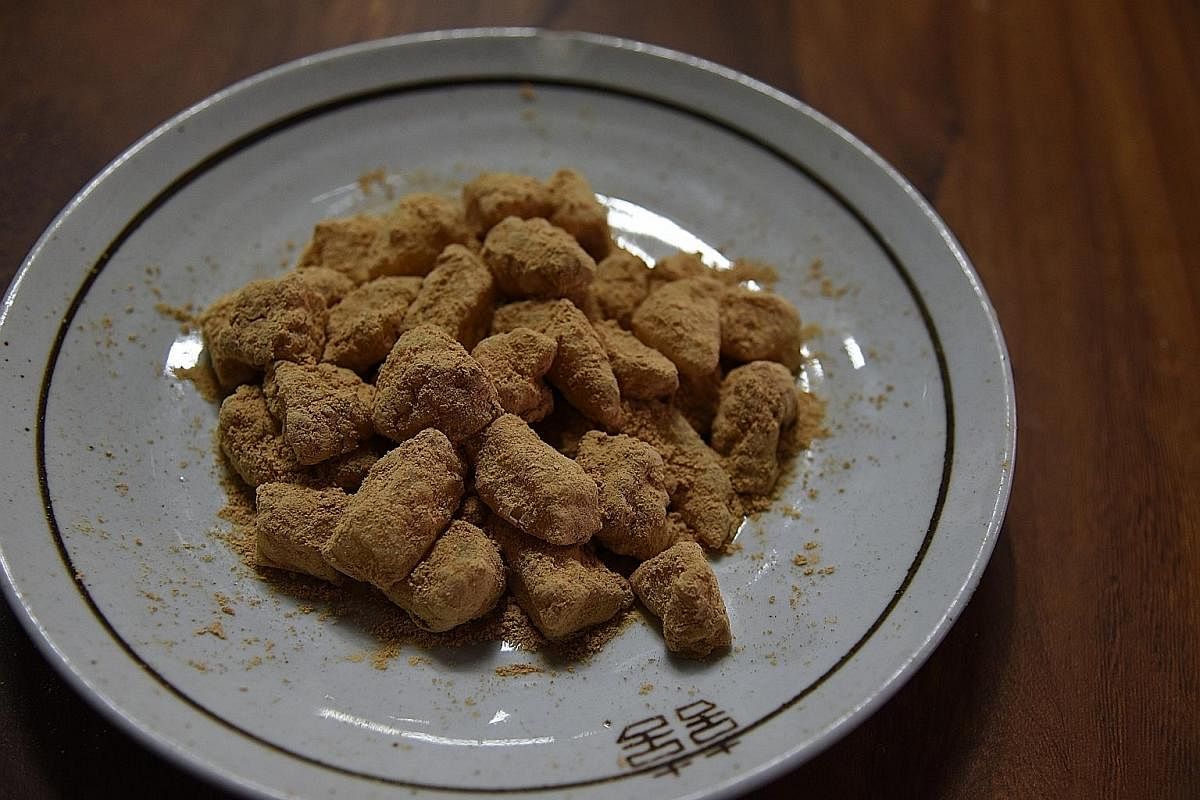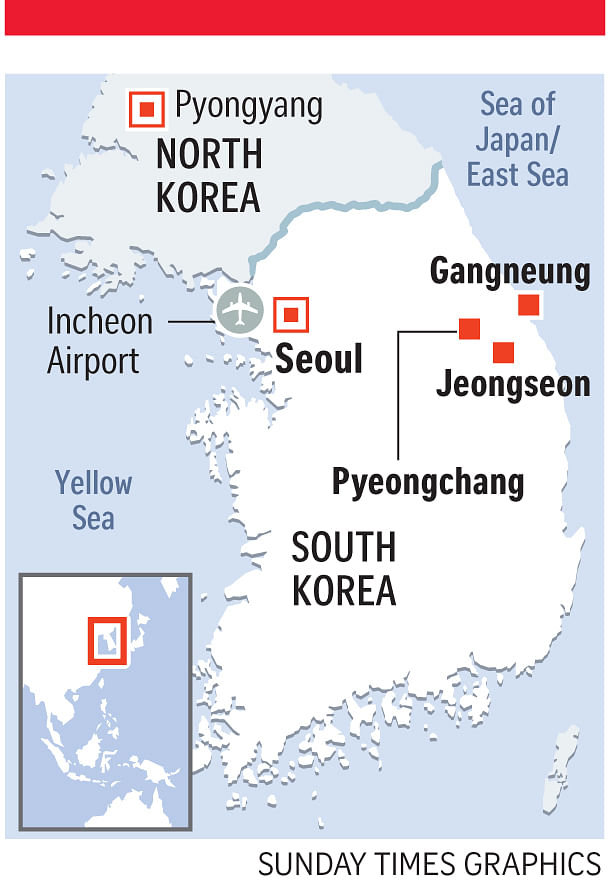-
GETTING THERE
-
There is no shortage of international flights from Singapore to Incheon International Airport, South Korea's largest airport.
A high-speed rail linking Incheon to Pyeongchang and other locations in Gangwon province is expected to be completed by the end of the year, in time for the Winter Olympics and Paralympics early next year. It will cut travel time to just 90 minutes.
For now, getting from Incheon or Seoul to Pyeongchang and other cities in the province is done by road. The journey takes about three hours, with shuttle buses running from both the airport and Seoul's city centre.
Wintry beauty of eastern Korea
Learn to ski, trek to a 1,300-year-old temple on a mountain and delve into a mine-turned-art museum in Gangwon province






With a circle of travellers as big as my 90-strong entourage of people of six nationalities, things tend to get chaotic and lost in translation, and there are often a few lost sheep as well.
But when we step onto a forest trail, softly sprinkled with snow and lined by majestic 100-year-old fir trees, only the soothing trickle of streams can be heard and the atmosphere changes.
Even chattering city-dwellers, five busloads of journalists and travel agents, know when to let the silence of nature take over.
I am in Pyeongchang, about to begin a gentle trek for a glimpse of one of the oldest temples in South Korea.
Not many travellers know about Pyeongchang in Gangwon province, a mountainous north-eastern region; fewer still will put it on their bucket list.

But just like how my moment in the forest unearths a hidden place with a touch of paradise, it requires no more than a three-hour road trip from Incheon International Airport to discover Pyeongchang and Jeongseon - two lesser-known cities we visit during a three-day sojourn in December.
PYEONGCHANG: WINTER OLYMPICS, RICE CAKES
Sports aficionados will be familiar with Pyeongchang as the host city of next year's Winter Olympics and Paralympics.
But I get the same response from almost everyone else, when they learn I am headed to this lessexplored place.
"You're going to North Korea?"
No, that would be Pyongyang, north of the demilitarised zone.
Pyeongchang, on the other hand, is some 80km south of the border and not nearly as well known. Its intriguing nickname, "Happy 700", however, suggests that this town of 43,000 deserves more attention.
Surrounded by towering ranges - the Taebaek Mountains to the east and Charyeong Mountains to the south-west - the numeral in Pyeongchang's nickname is derived from its altitude 700m above sea level.
"Happy" alludes to the belief that ideal living conditions are found at this altitude. For instance, the natural production of melatonin in our bodies is thought to be aided at these heights, hence slowing down the ageing process.
Crops are thought to grow better too - evident in the bountiful potatoes and rice that the province farms. Also, my guide tells me with bubbly enthusiasm: There is no such thing as a hangover here.
I need no sobering up, but the gentle winter breeze is refreshing when I take the 1km stroll through the fir forest. Soon, I am standing under the imposing gate of Woljeongsa Temple, on the eastern slopes of Mount Odaesan.
We are greeted by the abbot who, while dressed traditionally in grey garments known as a seungbok in Korean, is talking about K-pop star Psy.
Most people's understanding of South Korean culture is limited to viral music hits, such as Psy's Gangnam Style, and addictive television dramas. But at the heart of the country's culture, says this elderly monk, is Buddhism.
And there is no better place to imbibe that than at Woljeongsa.
Established more than 1,300 years ago, it is composed of 60 temples and eight monasteries filled with prized relics. The nine-storey octagonal Sari-Pagoda - a designated national treasure - is said to house sariras, or fragments of Buddha's cremated remains.
With its serene surroundings, Woljeongsa plays host to seekers who stay at the temple, whether in search of a better understanding of Korean Buddhism or simply wanting some meditation time.
While we do not have time to traipse further into temple grounds, it is not hard to see why a tranquil overnight stay is desirable.
The calm I experience is soon interrupted by hunger pangs, so my bid to understand Pyeongchang is redirected, naturally, to food.
French gourmand Jean Anthelme Brillat-Savarin probably said it best: "Tell me what you eat and I will tell you who you are." So what better way to know South Korean culture than to prepare our own food?
At Jeonggangwon (www.jeonggangwon.com), a traditional food culture experience centre, we crowd around sturdy wooden platforms. We will be making injeolmi, traditional South Korean rice cake, but first we have to work hard for the little treat.
Steaming glutinous rice is divided up in front of us and each group gets two hefty wooden mallets, known as ddeokmes, to strike the rice. Injeolmi prepared this way, we are told, is more delicious and chewy.
Each strike of the mallet is a fullbody workout. Thankfully, it does not take too much pummelling before the grains are rendered the right gooey texture, ready to be tossed in soya bean powder, then tossed into our mouths.
Making our main dish of bibimbap is a much more relaxing affair, since all that is needed is a good stir of the rice, meat, vegetables and mushrooms - all harvested locally from the mountains.
I am more than happy to let Jeonggangwon's seasoned ajummas, or aunties, take the lead and just focus on my appetite.
JEONGSEON: ART MINE, SKI SLOPES
Gangwon province is typically 2 to 3 deg C colder than the capital, Seoul, and it receives the most snowfall in South Korea annually. Just days before our arrival, travel advisories had to be issued in the province after some areas received as much as 38cm of snow.
So it is no wonder the region is a haven for snow sports lovers, come winter, and certainly the names of the ski resorts allude to this.
In Pyeongchang, Alpensia Ski Resort, for instance, derives its name from "Alpen", the German word for "the Alps", thus suggesting that the region is the Alps of Asia.
And here in Jeongseon itself, there is High1 Resort - where our group ends up - for slopes that go up to 1,367m on Baekwoon Mountain.
Many of these resorts organise ski festivals - such as High1's Go-Go Ski Festival - popular with visitors from tropical countries. They offer packages that include skiing and snowboarding lessons, as well as competitions for all ages and abilities.
At the foot of High1's slopes, I clip my cumbersome boots into a pair of skis, the first time in more than six years that I am doing so. I certainly need a refresher course for my endeavour here.
But skiing, I realise, is much like swimming - you do not forget how to drift down inclines of powdery snow, just as you always remember how to float on water.
High1 offers three peaks and 18 slopes of varying difficulties, catering to beginners and also those capable of zipping down International Ski Federation-certified courses. I have my sights set on the Valley course which, despite being the longest at 4.2km, is mostly straight with a low incline.
Much to my disappointment, the course is closed for the day, so I am resigned to the bunny slopes - which do not turn out that bad, given their proximity to the snowtubing hill.
As I discover, gliding down gentle slopes while sitting in a rubber tube, with little to no control over where I am headed or how fast I go, can be wildly addictive. I go back repeatedly, probably to the bewilderment of the 10-year-olds around me.
Also in Jeongseon is Samtan Art Mine, an easy stopover en route to Seoul or Incheon in the west. Some will recognise the mine from several scenes in Descendants Of The Sun, the biggest K-drama of last year. But for the uninitiated like myself, it is simply an art museum - but a very charming one.
The sprawling complex was converted from a coal mine that functioned for almost four decades before it was abandoned in the early 2000s. About a decade later, a twoyear restoration and remodelling process was started, before the museum opened in 2013.
Samtan Art Mine features more than 10,000 art pieces and relics from the private collection of founder Kim Min Seok, after his travels to more than 150 countries over three decades.
But what impresses me most is neither the notable art, nor the replica props and filming sets where the K-drama was shot, though these excite the many fans in our group.
Instead, it is that much of the complex's past identity as a coal mine has been preserved and incorporated into its new role as a museum.
From a room stacked full of health reports of the mine's former employees to the shower facilities they used and the ground-to-ceiling washing machines used to clean the clothes the miners wore, they do much to add to the character of the place, while offering a glimpse into Samtan's gritty former life.
The sun has set behind the mountains by the time we step out of the art museum. It is barely 5pm, but nightfall and the whiff of winter have a way of lulling us.
I lean back into my seat on the bus as we set off, unwittingly recalling what the old monk at Woljeongsa Temple said a day earlier.
There is more to South Korea than K-pop, K-drama, the bustling streets of Myeongdong in Seoul and the lush scenery of Jeju.
As I stare out at the snow-covered mountains, the undulating, unending ranges on the horizon seem to reinforce that lovely reality.
•The writer was hosted by the Korea Tourism Organisation.
Where to go
PYEONGCHANG
Alpensia Ski Resort and Ocean 700
Described as the "Alps of Asia", the ski resort will be the main venue for the Pyeongchang Winter Olympic Games next year. There are six slopes of varying difficulty for skiers of all levels.
A large water theme park, which is part of the resort, is filled with indoor facilities such as pools and mega-slides, besides outdoor pools.
Where: 325 Solbong-ro, Daegwallyeong-myeon, Pyeongchang-gun, Gangwon-do
Price: A ski package that includes an all-day lift pass and ski rental costs about $145 for adults and $108 for children. Day passes to the water park cost 57,000 won (S$69) for adults and 50,000 won for children
JEONGSEON
Hwaam Cave
This used to operate as the Cheonpo Goldmine from the 1920s to mid-1940s and has been converted into a museum that showcases its mining history. Visitors can see an 18.5kg gold bar and learn about the ecology of the cave.
Where: 2 Hwaamdolgul-gil, Hwaam-myeon, Jeongseon-gun, Gangwon-do
Admission: 5,000 won (adults), 3,500 won (teenagers), 2,000 won (children). Free for children aged six and younger and seniors aged 65 and above
High1 Resort
Considered one of South Korea's top ski resorts, it is equipped for people with disabilities. There is also a casino - the only one in the country open to locals. During the summer, a thrilling Alpine Coaster is also open.
Where: 265 High1-gil, Sabuk-eup, Jeongseon-gun, Gangwon-do
Price: A package including an all-day lift pass and ski rental costs about $130 for adults and $100 for children
GANGNEUNG
This coastal city is well known for its beautiful beaches and good coffee.
Pyeongchang House
Visitors will get a sneek peek into the progress of the Games' preparation and learn about the Winter Olympics. They can also take a 4D motion ride to learn about lesser-known sports such as bobsleighing and ski jumping. It will remain open even after the Olympics.
Where: 131, Nanseolheon-ro, Gangneung-si, Gangwon-do
Admission: Free
Anmok Beach
A popular vacation spot for families, it has in recent years also earned a reputation for its coffee culture. An annual coffee festival in early October features exhibitions, barista performances and seminars about the coffee industry.
Where: 16 Changhae-ro 14beon-gil, Gangneung-si, Gangwon-do
Admission: Free
Join ST's Telegram channel and get the latest breaking news delivered to you.
A version of this article appeared in the print edition of The Sunday Times on January 08, 2017, with the headline Wintry beauty of eastern Korea. Subscribe

